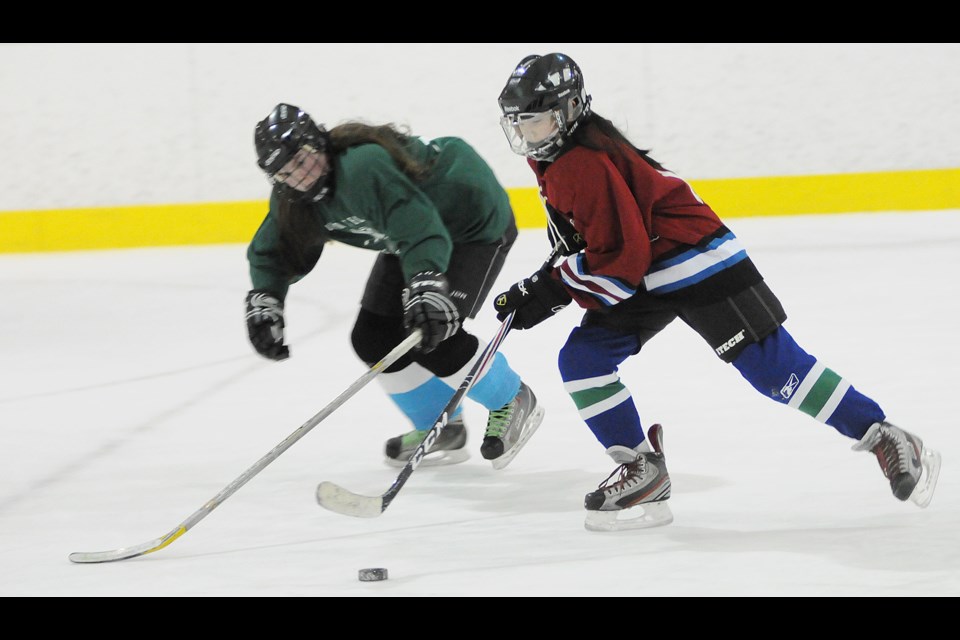Emma Lin was dropping by the ice rink almost every week to skate with friends when she was recruited to the Kitsilano hockey team.
The social skating was just for fun and she traded in her toe picks for hockey blades to play competitive sport.
“Hockey always seemed really fun to me,” said 17-year-old Lin. She tried out for the Blue Demons in November 2012 and played the first seasons on defence. Now the Grade 12 student is in net.
“When I first started, I didn't know how to do anything with a stick and puck,” she said. “Skating with all the hockey equipment was definitely weird at the beginning, especially my first time wearing the equipment was during try outs.
“I have become a better skater through the practices every week.”
The girls league launched in the 1995-96 season when club hockey was rapidly expanding to give girls and women more mainstream access to Canada’s national winter sport.
The high school league counted five teams — Vancouver Technical, Point Grey, Kitsilano, John Oliver and Killarney. J.O. has since folded but Churchill and Eric Hamber have added teams.
There are boys high school teams, but no city league.
The girls league still welcome first-time players like Lin. Many of the rosters also include athletes who have left other sports to play hockey although they have never skated before.
“We’ve got some girls who play rep hockey in the city leagues and those girls are pretty good and then we have others, it’s their first time playing and may be their only opportunity to play because of the cost to play,” said Jonathan Lai, who coaches at Van Tech alongside Michael Borason.
Three returning Trojans started their hockey at Van Tech and this season they count 10 rookies and about six more who play for city clubs like the Vancouver Angels.
The Trojans train at the Agrodome, but since ice time is limited, they have only three to five practices in a 10-game season. Their first game was Monday against Hamber at the Britannia Ice Rink. They lost 4-2.
Players bring their own sticks but those who don’t have their own gear can rely on the school for equipment like skates and pads.
“The league was initially created as a 'late-beginners' league, where girls who didn't necessarily play minor hockey could learn the game in a school environment, rather than in a minor hockey setting which might be a little more intimidating to the beginner,” wrote the league’s convener Mori Hamilton in an email to the Courier.
“Plus, for our experienced minor hockey players, it gives them a chance to have their talents recognized in the school athletics environment.”
Theresa MacLeod is the only woman who coaches in the high school league and said it’s key to see even first-time skaters as athletes with potential.
“You have to be aware of their ability,” she said.
Athletes who leave other sports bring one of those key intangibles that make their success in hockey very likely, even if it’s difficult at first.
“There’s that confidence where they know they can do it,” said MacLeod. “They feel it’s not their sport and you’re always going to get a brand new girl coming around. You have to take them by the hand and be very encouraging.
“It’s definitely a challenge but I tell you, when they get it, they get it. I love the enthusiasm they show.”
MacLeod remembers one player — a former gymnast named Katie Schertzer — who came out for the team. She’d never played hockey but eventually joined a minor hockey association and then competed for the UBC Thunderbirds as a goaltender.
“She had never played until later in life [but] she was good at all these acrobatic tumbling moves. It really worked for her,” said MacLeod. “You need to be flexible as a goalie. She caught on really well.”
MacLeod grew up with seven brothers who played hockey but she only picked up the sport as an adult.
“I want girls to get involved being active,” she said. “I tell the girls I’m jealous. I wish I had this when I was in high school.”
She’s not the only one.
Twitter.com/MHStewart



